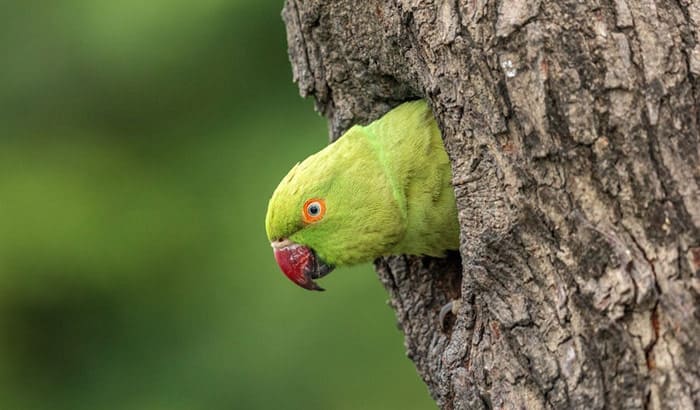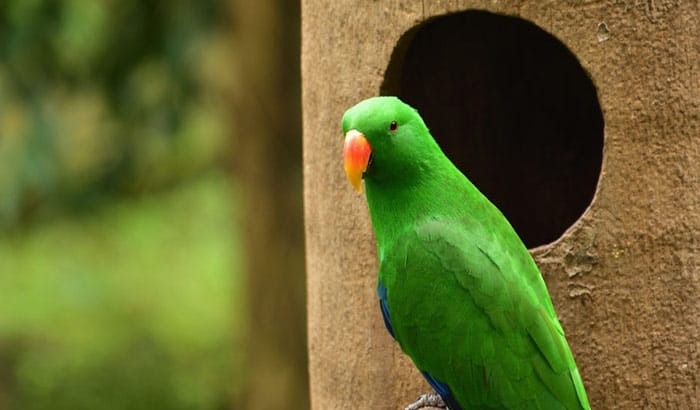If you have parakeets, parrotlets, lovebirds, or other small parrots in your home, you will need to provide them with a proper nest. Parakeets need a nest to rest; they also enjoy perching on top of it.
Building a nesting box is not that hard, as you can have fun with this DIY project. This blog post will show you how to make a parakeet nest from common household items that are easy to find. All it takes is some creativity and the right supplies!
Contents
How to Make a Parakeet Nest?
Step 1: Prepare the Wooden Box or Panels to Make a Wooden Nest.
You will need a small, clean container to make your parakeet’s nest. A wood container will work as long as it is relatively shallow and has no sharp edges.
Make sure the box size is big enough for your parrot(s) – ideally no smaller than 20 inches long and wide by 13 deep. Also, make sure there’s at least one-foot clearance from perch surface to ceiling (the higher, the better).
Use this information as a starting point only. If the parrot does not fit comfortably inside it must be larger or more spacious! They need room to stretch their wings without hitting walls!
Step 2: Gather some Soft Materials
To make the nest comfortable for your parakeet, you will need to gather some soft materials. A few good choices include cotton balls, tissue paper, or old T-shirts.
Parakeet’s favorite materials include paper towels/tissue (nonglazed), hay, fresh grass clippings, and straw. You can also opt for wood shavings made from soybean oil pressed /kiln-dried pine.
Step 3: Nail the Panels to Make the Box (If you do not have a Wooden Box Available)
This task should be done with nails and a small hammer. Make sure to secure all the pieces together to avoid the box breaking when your parakeet gets too excited.
Step 4: Cut a Hole in one Side
You should cut a hole at the bottom of one side of the box to serve as an entrance. The whole should have a diameter of around 1 inch.
Step 5: Put the Material in the Container
Once you have gathered your soft materials, put them in the container. Be sure to pack them down tightly so that they form a firm base for your parakeet to sit on.
Step 6: Put the Container in a Quiet Place
Once you have made your parakeet’s new home, be sure to put it somewhere quiet. With that, he will not be disturbed by noise or other pets. You can choose to place it at the top of a bookshelf with some branches for him to sit on.
If there is already one parakeet in the house, keep this tank separate from its current enclosure to avoid territorial aggression between them. Allow enough space around all sides of the parakeets’ new home for them to feel secure.
Step 7: Introduce your Parakeet to his New Nest
Once you have put the container in a quiet place, it is time to introduce your parakeet to his new nest.
Gently scoop him up and place him inside the container. If he seems hesitant, give him some time to explore on his own.
Once he is comfortable with the nest, offer him some food or water inside of it to start using it as his home base.
Make sure that you continue putting fresh food and water in the nest every day so that your parakeet always has access to them.
You have now learned how to make a parakeet nest. Be sure to keep the parakeet’s home clean and replace any materials that start looking dirty or worn out.
Will Parakeets Breed Without a Nest?
Yes, they can, since parakeets are one of the most common parrots in captivity. They have a reputation for being easier to keep than another parrot. However, breeding parakeets is more difficult without proper environments and materials.
Before allowing your parakeet breed, you should provide them with nesting material such as grasses or hay.
These materials can be placed inside an empty basket or box and hung up high enough. With that, their babies will not fall out when they hatch after about 20 days of incubation.
Parakeets’ diets when breeding:
- Correct parakeet food is also essential for breeding parakeets. A parrot diet of at least 50% greens, supplemented with vitamin-A-rich vegetables such as carrots, sweet potatoes, and dark leafy green will help to promote fertility in both male and female parrots
- Seeds are not a part of the parrot’s natural diet, so they should be avoided if possible. Otherwise, you can feed them with an organic seed mix that does not contain red millet or flaxseed, which can cause inflammation of the crop
- Your bird may refuse fresh foods when it comes time to nest but keep offering them until they eat some because this could make all the difference between successfully hatching eggs or losing them due to malnutrition
Correct parakeet food is also essential for breeding parakeets. A parrot diet of at least 50% greens, supplemented with vitamin-A-rich vegetables such as carrots, sweet potatoes, and dark leafy green will help to promote fertility in both male and female parrots.
Seeds are not a part of the parrot’s natural diet, so they should be avoided if possible. Otherwise, you can feed them with an organic seed mix that does not contain red millet or flaxseed, which can cause inflammation of the crop.
Your bird may refuse fresh foods when it comes time to nest but keep offering them until they eat some because this could make all the difference between successfully hatching eggs or losing them due to malnutrition.
Do Parakeets Build Nests?
Parakeets make a nest if they feel safe enough; most parrots like having privacy when nesting. Parakeet owners who want parrots to breed in captivity can help their parrots with this.
What to put in the Parakeet Nesting Box?
Parakeets are very social birds that love to live in parrots, so you can put just about anything they like in the nesting boxes.
Just remember these few rules:
- Put some soft material at the bottom of nesting boxes, so your parakeets have something comfortable to sit on while sleeping
- Don’t use metal materials because parrots chew on them constantly, resulting in sharp edges. Also, parrots can get their beaks stuck in metal if they try to escape the nest box!
- Please ensure there are no sharp points or objects inside the nesting box because the parrot will chew on them and injure itself
- Do not use paint, varnish, lacquer, or polyurethane. Parakeets may ingest it when spreading bedding into the nest box with their feet
- The nesting box should be placed in a quiet location where your parakeet can feel safe and secure
- Some people like to put a perch inside the nesting box, so their parakeets have a place to roost. Still, others find it encourages the parakeet to poop on everything! You’ll have to experiment and see what works best for you
Conclusion
Whether you are a pet owner or not, this article has provided some helpful information on how to make your parakeet nest. With some items around your home and some time on your hand, building a proper nest for your pet is possible.
If you have any more questions, please feel free to contact us; we would be happy to help!


